Psychosocial interventions for self-harm in adults
- PMID: 27168519
- PMCID: PMC8786273
- DOI: 10.1002/14651858.CD012189
Psychosocial interventions for self-harm in adults
Abstract
Background: Self-harm (SH; intentional self-poisoning or self-injury) is common, often repeated, and associated with suicide. This is an update of a broader Cochrane review first published in 1998, previously updated in 1999, and now split into three separate reviews. This review focuses on psychosocial interventions in adults who engage in self-harm.
Objectives: To assess the effects of specific psychosocial treatments versus treatment as usual, enhanced usual care or other forms of psychological therapy, in adults following SH.
Search methods: The Cochrane Depression, Anxiety and Neurosis Group (CCDAN) trials coordinator searched the CCDAN Clinical Trials Register (to 29 April 2015). This register includes relevant randomised controlled trials (RCTs) from: the Cochrane Library (all years), MEDLINE (1950 to date), EMBASE (1974 to date), and PsycINFO (1967 to date).
Selection criteria: We included RCTs comparing psychosocial treatments with treatment as usual (TAU), enhanced usual care (EUC) or alternative treatments in adults with a recent (within six months) episode of SH resulting in presentation to clinical services.
Data collection and analysis: We used Cochrane's standard methodological procedures.
Main results: We included 55 trials, with a total of 17,699 participants. Eighteen trials investigated cognitive-behavioural-based psychotherapy (CBT-based psychotherapy; comprising cognitive-behavioural, problem-solving therapy or both). Nine investigated interventions for multiple repetition of SH/probable personality disorder, comprising emotion-regulation group-based psychotherapy, mentalisation, and dialectical behaviour therapy (DBT). Four investigated case management, and 11 examined remote contact interventions (postcards, emergency cards, telephone contact). Most other interventions were evaluated in only single small trials of moderate to very low quality.There was a significant treatment effect for CBT-based psychotherapy compared to TAU at final follow-up in terms of fewer participants repeating SH (odds ratio (OR) 0.70, 95% confidence interval (CI) 0.55 to 0.88; number of studies k = 17; N = 2665; GRADE: low quality evidence), but with no reduction in frequency of SH (mean difference (MD) -0.21, 95% CI -0.68 to 0.26; k = 6; N = 594; GRADE: low quality).For interventions typically delivered to individuals with a history of multiple episodes of SH/probable personality disorder, group-based emotion-regulation psychotherapy and mentalisation were associated with significantly reduced repetition when compared to TAU: group-based emotion-regulation psychotherapy (OR 0.34, 95% CI 0.13 to 0.88; k = 2; N = 83; GRADE: low quality), mentalisation (OR 0.35, 95% CI 0.17 to 0.73; k = 1; N = 134; GRADE: moderate quality). Compared with TAU, dialectical behaviour therapy (DBT) showed a significant reduction in frequency of SH at final follow-up (MD -18.82, 95% CI -36.68 to -0.95; k = 3; N = 292; GRADE: low quality) but not in the proportion of individuals repeating SH (OR 0.57, 95% CI 0.21 to 1.59, k = 3; N = 247; GRADE: low quality). Compared with an alternative form of psychological therapy, DBT-oriented therapy was also associated with a significant treatment effect for repetition of SH at final follow-up (OR 0.05, 95% CI 0.00 to 0.49; k = 1; N = 24; GRADE: low quality). However, neither DBT vs 'treatment by expert' (OR 1.18, 95% CI 0.35 to 3.95; k = 1; N = 97; GRADE: very low quality) nor prolonged exposure DBT vs standard exposure DBT (OR 0.67, 95% CI 0.08 to 5.68; k = 1; N =18; GRADE: low quality) were associated with a significant reduction in repetition of SH.Case management was not associated with a significant reduction in repetition of SH at post intervention compared to either TAU or enhanced usual care (OR 0.78, 95% CI 0.47 to 1.30; k = 4; N = 1608; GRADE: moderate quality). Continuity of care by the same therapist vs a different therapist was also not associated with a significant treatment effect for repetition (OR 0.28, 95% CI 0.07 to 1.10; k = 1; N = 136; GRADE: very low quality). None of the following remote contact interventions were associated with fewer participants repeating SH compared with TAU: adherence enhancement (OR 0.57, 95% CI 0.32 to 1.02; k = 1; N = 391; GRADE: low quality), mixed multimodal interventions (comprising psychological therapy and remote contact-based interventions) (OR 0.98, 95% CI 0.68 to 1.43; k = 1 study; N = 684; GRADE: low quality), including a culturally adapted form of this intervention (OR 0.83, 95% CI 0.44 to 1.55; k = 1; N = 167; GRADE: low quality), postcards (OR 0.87, 95% CI 0.62 to 1.23; k = 4; N = 3277; GRADE: very low quality), emergency cards (OR 0.82, 95% CI 0.31 to 2.14; k = 2; N = 1039; GRADE: low quality), general practitioner's letter (OR 1.15, 95% CI 0.93 to 1.44; k = 1; N = 1932; GRADE: moderate quality), telephone contact (OR 0.74, 95% CI 0.42 to 1.32; k = 3; N = 840; GRADE: very low quality), and mobile telephone-based psychological therapy (OR not estimable due to zero cell counts; GRADE: low quality).None of the following mixed interventions were associated with reduced repetition of SH compared to either alternative forms of psychological therapy: interpersonal problem-solving skills training, behaviour therapy, home-based problem-solving therapy, long-term psychotherapy; or to TAU: provision of information and support, treatment for alcohol misuse, intensive inpatient and community treatment, general hospital admission, or intensive outpatient treatment.We had only limited evidence on whether the intervention had different effects in men and women. Data on adverse effects, other than planned outcomes relating to suicidal behaviour, were not reported.
Authors' conclusions: CBT-based psychological therapy can result in fewer individuals repeating SH; however, the quality of this evidence, assessed using GRADE criteria, ranged between moderate and low. Dialectical behaviour therapy for people with multiple episodes of SH/probable personality disorder may lead to a reduction in frequency of SH, but this finding is based on low quality evidence. Case management and remote contact interventions did not appear to have any benefits in terms of reducing repetition of SH. Other therapeutic approaches were mostly evaluated in single trials of moderate to very low quality such that the evidence relating to these interventions is inconclusive.
Conflict of interest statement
KH and DG each authored three of the trials included in the review, EA authored two trials, and KvH is the author of one of the trials.
Figures
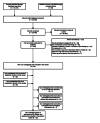


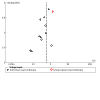
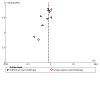
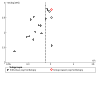
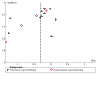
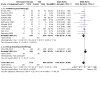
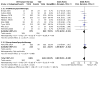


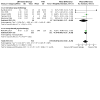

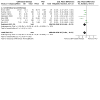
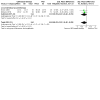

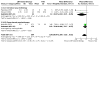
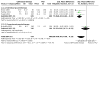
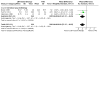


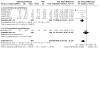

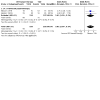
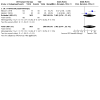
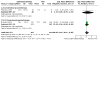

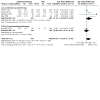
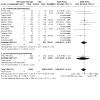
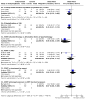
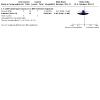
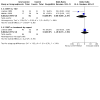
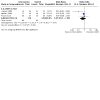
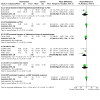

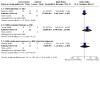
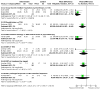


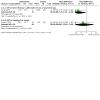

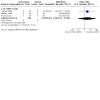
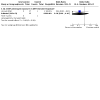
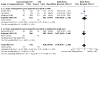
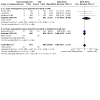
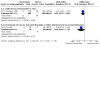

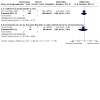
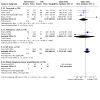
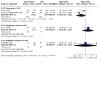
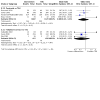
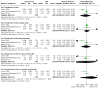

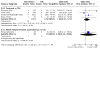
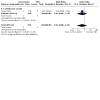
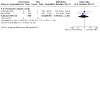
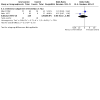
Comment in
-
[The soothing pain].Ugeskr Laeger. 2016 Nov 28;178(48):V68569. Ugeskr Laeger. 2016. PMID: 27908319 Danish. No abstract available.
References
References to studies included in this review
Allard 1992 {published data only}
-
- Allard R, Marshall M, Plante MC. Intensive follow-up does not decrease the risk of repeat suicide attempts. Suicide and Life-Threatening Behavior 1992;22(3):303-14. - PubMed
Bateman 2009 {published and unpublished data}27660668
-
- Bateman A, Fonagy P. Randomized controlled trial of outpatient mentalization-based treatment versus structured clinical management for borderline personality disorder. American Journal of Psychiatry 2009;166(12):1355-64. - PubMed
Beautrais 2010 {published and unpublished data}
-
- Beautrais AL, Gibb SJ, Faulkner A, Fergusson DM, Mulder RT. Postcard intervention for repeat self-harm: randomised controlled trial. British Journal of Psychiatry 2010;197(1):55-60. - PubMed
Bennewith 2002 {published data only}
Brown 2005 {published data only}
-
- Brown GK, Ten Have T, Henriques GR, Xie SX, Hollander JE, Beck AT. Cognitive therapy for the prevention of suicide attempts: a randomized controlled trial. Journal of the American Medical Association 2005;294(5):563-70. - PubMed
-
- Ghahramanlou-Holloway M, Bhar SS, Brown GK, Olsen C, Beck AT. Changes in problem-solving appraisal after cognitive therapy for the prevention of suicide. Psychological Medicine 2012;42(6):1185-93. - PubMed
Carter 2005 {published and unpublished data}
-
- Carter GL, Clover K, Whyte IM, Dawson AH, D'este C. Postcards from the EDge: 24-month outcomes of a randomised controlled trial for hospital-treatment self-poisoning. British Journal of Psychiatry 2007;191:548-53. - PubMed
Cedereke 2002 {published data only}
-
- Cedereke M, Monti K, Ojehagen A. Telephone contact with patients in the year after a suicide attempt: Does it affect treatment attendance and outcome? A randomised controlled study. European Psychiatry 2002;17(2):82-91. - PubMed
Clarke 2002 {published data only}
-
- Clarke T, Baker P, Watts CJ, Williams K, Feldman RA, Sherr L. Self-harm in adults: A randomised controlled trial of nurse-led case management versus routine care only. Journal of Mental Health 2002;11(2):167-76.
Crawford 2010 {published and unpublished data}
-
- Crawford MJ, Csipke E, Brown A, Reid S, Nilsen K, Redhead J, Touquet R. The effect of referral for brief intervention for alcohol misuse on repetition of deliberate self-harm: an exploratory randomized controlled trial. Psychological Medicine 2010;40(11):1821-8. - PubMed
Davidson 2014 {published and unpublished data}
Dubois 1999 {published data only}
-
- Dubois L, Walter M, Bleton L, Genest P, Lemonnier E, Lachevre G. Evaluation of a comparative and prospective protocol for suicidal youth: analysis of psychiatric diagnosis, therapeutic compliance and rate of recurrence over one year (preliminary results) [Evaluation comparative et prospective d'un protocole de prise en charge specifique de jeunes suicidants: Analyse du diagnostic psychiatrique initial, de l'observance therapeutique et du taux de recidive a un an (resultats preliminaires)]. Annales Medico-Psychologiques 1999;157:557-61.
Evans 1999a {published data only}
-
- Evans J, Evans M, Morgan HG, Hayward A, Gunnell, D. Crisis card following self-harm: 12-month follow-up of a randomised controlled trial. British Journal of Psychiatry 2005;187:186-187. - PubMed
-
- Evans MO, Morgan HG, Hayward A, Gunnell DJ. Crisis telephone consultation for deliberate self-harm patients: effects on repetition. British Journal of Psychiatry 1999;175:23-7. - PubMed
Evans 1999b {published data only}
-
- Evans K, Tyrer P, Catalan J, Schmidt U, Davidson K, Dent J, Tata P, Thornton S, Barber J, Thompson S. Manual-assisted cognitive-behaviour therapy (MACT): A randomized controlled trial of a brief intervention with bibliotherapy in the treatment of recurrent deliberate self-harm. Psychological Medicine 1999;29(1):19-25. - PubMed
Fleischmann 2008 {published and unpublished data}
-
- Bertolote JM, Fleischmann A, De Leo D, Phillips MR, Botega NJ, Vijayakumar L, De Silva D, Schlebusch L, Nguyen VT, Sisask M, Bolhari J, Wasserman D. Repetition of suicide attempts: Data from five culturally different low- and middle-income country emergency care settings participating in the WHO SUPRE-MISS study. Crisis: The Journal of CrisisIntervention and Suicide Prevention 2010;31(4):194-201. - PubMed
-
- Fleischmann A, Bertolote JM, Wasserman D, De Leo D, Bolhari J, Botega NJ, De Silva D, Phillips M, Vijayakumar L, Värnik A, Schlebusch L, Thanh HT. Effectiveness of brief intervention and contact for suicide attempters: A randomized controlled trial in five countries. Bulletin of the World Health Organisation 2008;86(9):703-9. - PMC - PubMed
-
- Hassanzadeh M, Khajeddin N, Nojomi M, Fleischmann A, Eshrati T. Brief intervention and contact after deliberate self-harm: an Iranian randomised controlled trial. Iranian Journal of Psychiatry and Behavioral Sciences 2010;4(2):5-12.
-
- Xu D, Zhang X-L, Li X-Y, Niu Y-J, Zhang Y-P, Wang S-L, et al. Effectiveness of 18-month psychosocial intervention for suicide attempters. Zhongguo Xinli Weisheng Zazhi [Chinese Mental Health Journal] 2012;26:24-9.
Gibbons 1978 {published data only}
-
- Gibbons JS, Butler J, Urwin P, Gibbons JL. Evaluation of a social work service for self-poisoning patients. British Journal of Psychiatry 1978;133:111-118. - PubMed
Gratz 2006 {published and unpublished data}
-
- Gratz KL, Gunderson JG. Preliminary data on an acceptance-based emotion regulation group intervention for deliberate self-harm among women with borderline personality disorder. Behavior Therapy 2006;37(1):25-35. - PubMed
Gratz 2014 {published and unpublished data}
-
- Gratz KL, Tull MT, Levy R. Randomized controlled trial and uncontrolled 9-month follow-up of an adjunctive emotion regulation group therapy for deliberate self-harm among women with borderline personality disorder. Psychological Medicine 2013;44(10):2099-122. - PubMed
Guthrie 2001 {published data only}
Harned 2014 {published and unpublished data}
-
- Harned MS, Korslund KE, Linehan MM. A pilot randomized controlled trial of dialectical behavior therapy with and without the dialectical behavior therapy prolonged exposure protocol for suicidal and self-injuring women with borderline personality disorder and PTSD. Behaviour Research and Therapy 2014;55:7-17. - PMC - PubMed
Hassanian‐Moghaddam 2011 {published and unpublished data}
-
- Hassanian-Moghaddam H, Sarjami S, Kolahi A-A, Carter GL. Postcards in Persia: Randomised controlled trial to reduce suicidal behaviours 12 months after hospital-treated self-poisoning. British Journal of Psychiatry 2011;198(4):309-16. - PubMed
-
- Hassanian-Moghaddam H, Sarjami S, Kolahi A-A, Lewin T, Carter G. Postcards in Persia: A 12-24 month follow-up of a randomised controlled trial for hospital treated deliberate self-poisoning. Archives of Suicide Research 2015;Epub ahead of print:DOI: 10.1080/13811118.2015.1004473. - PubMed
Hatcher 2011 {published and unpublished data}
-
- Hatcher S, Sharon C, Parag V, Collins N. Problem-solving therapy for people who present to hospital with self-harm: Zelen randomised controlled trial. British Journal of Psychiatry 2011;199(4):310-6. - PubMed
Hatcher 2015 {published and unpublished data}
-
- Hatcher S, Sharon C, House A, Collins N, Collings S, Pillai A. The ACCESS study: Zelen randomised controlled trial of a package of care for people presenting to hospital after self-harm. British Journal of Psychiatry 2015;206(3):229-36. - PubMed
Hatcher 2016a {published and unpublished data}
-
- Hatcher S, Coupe N, Wikirwhi K, Durie M, Pillai A. Te Ira Tangaga: A Zelen randomised controlled trial of A culturally informed treatment compared to treatment as usual in Maori who present to hospital after self-harm. Social Psychiatry and Psychiatric Epidemiology 2016;Epub ahead of print:DOI: 10.1007/s00127-016-1194-7. - PubMed
Hawton 1981 {published and unpublished data}
-
- Hawton K, Bancroft J, Catalan J, Kingston B, Stedeford A. Domiciliary and out-patient treatment of self-poisoning patients by medical and non-medical staff. Psychological Medicine 1981;11(1):169-77. - PubMed
Hawton 1987a {published and unpublished data}
-
- Hawton K, McKeown S, Day A, Martin P, O'Connor M, Yule J. Evaluation of out-patient counselling compared with general practitioner care following overdoses. Psychological Medicine 1987;17(3):751-61. - PubMed
Husain 2014 {published and unpublished data}
-
- Husain N, Afsar S, Ara J, Fayyaz H, Ur Rahman R, Tomenson B, et al. Brief psychological intervention after self-harm: randomised controlled trial from Pakistan. British Journal of Psychiatry 2014;204(6):462-70. - PubMed
Hvid 2011 {published and unpublished data}
-
- Hvid M, Vangborg K, Sørensen HJ, Nielsen IK, Stenborg JM, Wang AG. Preventing repetition of attempted suicide - II: The Amager Project, a randomized controlled trial. Nordic Journal of Psychiatry 2011;65(5):292-8. - PubMed
Kapur 2013a {published data only}65171515
-
- Kapur N, Gunnell D, Hawton K, Nadeem S, Khalil S, Longson D, Jordan R, Donaldson I, Emsley R, Cooper J. Messages from Manchester: Pilot randomised controlled trial following self-harm. British Journal of Psychiatry 2013;203(1):73-4. - PubMed
Kawanishi 2014 {published and unpublished data}
-
- Kawanishi C, Aruga T, Ishizuka N, Yonemoto N, Otsuka K, Kamijo Y, Okubo Y, Ikeshita K, Sakai A, Miyaoka H, Hitomi Y, Iwakuma A, Kinoshita T, Akiyoshi J, Horikawa N, Hirotsune H, Eto N, Iwata N, Kohno M, Iwanami A, Mimura M, Asada T, Hirayasu Y on behalf of the ACTION-J Group. Assertive case management versus enhanced usual care for people with mental health problems who had attempted suicide and were admitted to hospital emergency departments in Japan (ACTION-J): A multicentre, randomised controlled trial. The Lancet Psychiatry 2014;1(3):193-201. - PubMed
Liberman 1981 {published data only}
-
- Liberman RP, Eckman T. Behavior therapy vs insight-oriented therapy for repeated suicide attempters. Archives of General Psychiatry 1981;38(10):1126-30. - PubMed
Linehan 1991 {published data only}
-
- Linehan MM, Armstrong HE, Suarez A, Allmon D, Heard HL. Cognitive-behavioral treatment of chronically parasuicidal borderline patients. Archives of General Psychiatry 1991;48(12):1060-4. - PubMed
-
- Linehan MM, Heard HL, Armstrong HE. Naturalistic follow-up of a behavioral treatment for chronically parasuicidal borderline patients. Archives of General Psychiatry 1993;50(12):971-4. - PubMed
Linehan 2006 {published and unpublished data}
-
- Bedics JD, Atkins DC, Comtois JA, Linehan MM. Treatment differences in the therapeutic relationship and introject during a 2-year randomized controlled trial of dialectical behavior therapy versus non-behavioral psychotherapy experts for borderline personality disorder. Journal of Consulting and Clinical Psychology 2012;80(1):66-77. - PMC - PubMed
-
- Bedics JD, Atkins DC, Harned MS, Linehan MM. The therapeutic alliance as a predictor of outcome in dialectical behavior therapy versus nonbehavioral psychotherapy by experts for borderline personality disorder. Psychotherapy: Theory, Research and Practice 2015;52(1):67-77. - PubMed
-
- Harned MS, Chapman AL, Dexter-Mazza ET, Murray A, Comtois KA, Linehan MM. Treating co-occurring axis I disorders in recurrently suicidal women with borderline personality disorder: A 2-year randomized trial of dialectical behavior therapy versus community treatment by experts. Journal of Consulting and Clinical Psychology 2008;76(6):1068-75. - PubMed
-
- Harned MS, Chapman AL, Dexter-Mazza ET, Murray A, Comtois KA, Linehan MM. Treating co-occurring axis I disorders in recurrently suicidal women with borderline personality disorder: A 2-year randomized trial of dialectical behavior therapy versus community treatment by experts. Personality Disorders: Theory, Research and Treatment 2009;5:35-45. - PubMed
-
- Linehan MM, Comtois KA, Murray AM, Brown MZ, Gallop RJ, Heard HL, et al. Two-year randomized controlled trial and follow-up of dialectical behavior therapy vs therapy by experts for suicidal behaviors and borderline personality disorder. Archives of General Psychiatry 2006;63(7):757-66. - PubMed
Marasinghe 2012 {published and unpublished data}
-
- Marasinghe RB, Edirippulige S, Kavanagh D, Smith A, Jiffry MTM. Effect of mobile phone-based psychotherapy in suicide prevention: A randomized controlled trial in Sri Lanka. Journal of Telemedicine and Telecare 2012;18(3):151-5. - PubMed
-
- Marasinghe RB. Evaluation of a Brief Inpatient and Community Intervention to Address Suicide Risk in Sri Lanka Using Mobile Phones [PhD thesis]. Brisbane, Australia: The Univerity of Queensland, School of Medicine, 2012.
McAuliffe 2014 {published and unpublished data}
-
- McAuliffe C, McLeavey BC, Fitzgerald T, Corcoran P, Carroll B, Ryan L, O'Keeffe B, Fitzgerald E, Hickey P, O'Regan M, Mulqueen J, Arensman E. Group problem-solving skills training for self-harm: Randomised controlled trial. British Journal of Psychiatry 2014;204:383-90. - PubMed
McLeavey 1994 {published data only}
-
- McLeavey B, Daly R, Ludgate J, Murray C. Interpersonal problem-solving skills training in the treatment of self-poisoning patients. Suicide and Life-Threatening Behavior 1994;24(4):382-94. - PubMed
McMain 2009 {published and unpublished data}
-
- Case BG. Dialectical behavior therapy versus general psychiatric management in the treatment of borderline personality disorder. American Journal of Psychiatry 2010;167(4):475. - PubMed
-
- McMain SF, Guimond T, Streiner DL, Cardish RJ, Links PS. Dialectical behavior therapy compared with general psychiatric management for borderline personality disorder: Clinical outcomes and functioning over a 2-year follow-up. American Journal of Psychiatry 2012;169(6):650-61. - PubMed
-
- McMain SF, Links PS, Gnam WH, Guimond T, Cardish RJ, Korman L, Streiner DL. A randomized trial of dialectical behavior therapy versus general psychiatric management for borderline personality disorder. American Journal of Psychiatry 2009;166(12):1365-74. - PubMed
Morgan 1993 {published data only}
-
- Morgan HG, Jones EM, Owen JH. Secondary prevention of non-fatal deliberate self-harm. The green card study. British Journal of Psychiatry 1993;163:111-2. - PubMed
Morthorst 2012 {published data only}
Patsiokas 1985 {published data only}
-
- Patsiokas AT, Clum GA. Effects of psychotherapeutic strategies in the treatment of suicide attempters. Psychotherapy: Theory, Research and Practice 1985;22(2):281-90.
Priebe 2012 {published and unpublished data}
-
- Priebe S, Bhatti N, Barnicot K, Bremner S, Gaglia A, Katsakou C, Molosankwe I, McCrone P, Zinkler M. Effectiveness and cost-effectiveness of dialectical behaviour therapy for self-harming patients with personality disorder: A pragmatic randomised controlled trial. Psychotherapy and Psychosomatics 2012;81(6):356-65. - PubMed
Salkovskis 1990 {published data only}
-
- Salkovskis PM, Atha C, Storer D. Cognitive-behavioural problem solving in the treatment of patients who repeatedly attempt suicide. A controlled trial. British Journal of Psychiatry 1990;157:871-876. - PubMed
Slee 2008 {published and unpublished data}
-
- Slee N, Garnefski N, Van der Leeden R, Arensman E, Spinhoven P. Cognitive-behavioural intervention for self-harm: Randomised controlled trial. British Journal of Psychiatry 2008;192:202-11. - PubMed
Stewart 2009 {published and unpublished data}
-
- Stewart CD, Quinn A, Plever S, Emmerson B. Comparing cognitive behavior therapy, problem solving therapy, and treatment as usual in a high risk population. Suicide and Life-Threatening Behavior 2009;39(5):538-47. - PubMed
Tapolaa 2010 {published and unpublished data}
-
- Tapolaa V, Lappalainen R, Wahlström J. Brief intervention for deliberate self-harm: An exploratory study. Suicidology Online 2010;1:95-108.
Torhorst 1987 {published data only}
-
- Torhorst A, Möller HJ, Bürk F, Kurz A, Wächtler C, Lauter H. The psychiatric management of parasuicide patients: A controlled clinical study comparing different strategies of outpatient treatment. Crisis 1987;8(1):53-61. - PubMed
Torhorst 1988 {published data only}
-
- Torhorst A, Möller HJ, Kurz A, Schmid-Bode W, Lauter H. Comparing a 3-month and a 12-month-outpatient aftercare program for parasuicide repeaters. In: Möller HJ, Schmidtke A, Welz R, editors(s). Current Issues of Suicidology. Berlin, Germany: Springer-Verlag, 1988:419-24.
Turner 2000 {published data only}
-
- Turner RM. Naturalistic evaluation of dialectical behavior therapy-oriented treatment for borderline personality disorder. Cognitive and Behavioral Practice 2000;7(4):413-9.
Tyrer 2003 {published data only}
-
- Tyrer P, Thompson S, Schmidt U, Jones V, Knapp M, Davidson K, Catalan J, Airlie J, Baxter S, Byford S, Byrne G, Cameron S, Caplan R, Cooper S, Ferguson B, Freeman C, Frost S, Godley J, Greenshields J, Henderson J, Holden N, Keech P, Kim L, Logan K, Manley C, MacLeod A, Murphy R, Patience L, Ramsay L, De Munroz S, Scott J, Seivewright H, Sivakumar K, Tata P, Thornton S, Ukoumunne OC, Wessely S. Randomized controlled trial of brief cognitive behaviour therapy versus treatment as usual in recurrent deliberate self-harm: The POPMACT study. Psychological Medicine 2003;33(6):969-76. - PubMed
Vaiva 2006 {published data only}
Van der Sande 1997a {published data only}
-
- Van der Sande R, Buskens E, Van der Graaf Y, Van Rooijen E, Allart E, Van Engeland H. No measurable effect from general socio-psychiatric care for those attempting suicide: A randomized experiment [Geen meetbaar effect van algemene sociaal-psychiatrische nazorg voor suicidepogers; een gerandomiseerd experiment]. Nederlands Tijdschrift voor de Geneeskunde 1998;142:2356.
-
- Van der Sande R, Van Rooijen L, Buskens E, Allart E, Hawton K, Van der Graaf Y, Van Engeland H. Intensive in-patient and community intervention versus routine care after attempted suicide. A randomised controlled intervention study. British Journal of Psychiatry 1997;171:35-41. - PubMed
Van Heeringen 1995 {published data only}
-
- Van Heeringen C, Jannes S, Buylaert W, Hendrick H, De Bacquer D, Van Remoortel J. The management of non-compliance with referral to out-patient after-care among attempted suicide patients: A controlled intervention study. Psychological Medicine 1995;25(5):963-70. - PubMed
Waterhouse 1990 {published data only}
-
- Waterhouse J, Platt S. General hospital admission in the management of parasuicide. A randomised controlled trial. British Journal of Psychiatry 1990;156:236-242. - PubMed
Wei 2013 {published data only}
-
- Wei S, Liu L, Bi B, Li H, Hou J, Tan S, Chen X, Chen W, Jia X, Dong G, Qin X, Liu Y. An intervention and follow-up study following a suicide attempt in the emergency departments of four general hospitals in Shenyang, China. Crisis 2013;34(2):107-15. - PubMed
Weinberg 2006 {published data only}
-
- Weinberg I, Gunderson JG, Hennen J, Cutter CJ. Manual assisted cognitive treatment for deliberate self-harm in borderline personality disorder patients. Journal of Personality Disorders 2006;20(5):482-92. - PubMed
Welu 1977 {published data only}
-
- Welu T. A follow-up program for suicide attempters: Evaluation of effectiveness. Suicide and Life-Threatening Behavior 1977;7(1):17-30. - PubMed
References to studies excluded from this review
Almeida 2012 {published data only}
-
- Almeida OP, Pirkis J, Kerse N, Sim M, Flicker L, Snowdon J, Draper B, Byrne G, Goldney R, Lautenschlager NT, Stocks N, Alfonso H, Pfaff JJ. A randomized trial to reduce the prevalence of depression and self-harm behavior in older primary care patients. Annals of Family Medicine 2012;10(4):347-56. - PMC - PubMed
Aoun 1999 {published data only}
-
- Aoun S. Deliberate self-harm in rural Western Australia: Results of an intervention study. Australian and New Zealand Journal of Mental Health Nursing 1999;8(2):65-73. - PubMed
Bannan 2010 {published and unpublished data}
-
- Bannan, N. Group-based problem-solving therapy in self-poisoning females: A pilot study. Counselling and Psychotherapy Research 2010;10(3):201-13.
Bartman 1979 {published data only}
-
- Bartman ER. Assertive training with hospitalized suicide attempters [PhD thesis]. Washington DC: Catholic University of America, 1979.
Bateson 1989 {published data only}
-
- Bateson M, Oliver JPJ, Goldberg DP. A comparative study of the management of cases of deliberate self-harm in a district general hospital. British Journal of Social Work 1989;19(1):461-78.
Berrino 2011 {published data only}
-
- Berrino A, Ohlendorf P, Duriaux S, Burnand Y, Lorillard S, Andreoli A. Crisis intervention at the general hospital: An appropriate treatment choice for acutely suicidal borderline patients. Psychiatry Research 2011;186(2-3):287-92. - PubMed
Carter 2013 {published data only}
-
- Carter GL, Clover K, Whyte IM, Dawson AH, D'este C. Postcards from the EDge: 5-year outcomes of a randomised controlled trial for hospital-treated self-poisoning. British Journal of Psychiatry 2013;202:372-80. - PubMed
Cebrià 2013 {published data only}
-
- Cebrià AI, Parra I, Pàmias M, Escayola A, García-Parés G, Puntí J, Laredo A, Vallès V, Cavero M, Oliva JC, Hegerl U, Pérez-Solà V, Palao DJ. Effectiveness of a telephone management programme for patients discharged from an emergency department after a suicide attempt: Controlled study in a Spanish population. Journal of Affective Disorders 2013;147(1-3):269-76. - PubMed
Chen 2013 {published and unpublished data}
Chowdhury 1973 {published data only}
-
- Chowdhury N, Hicks R, Kreitman N. Evaluation of an after-care service for parasuicide (attempted suicide) patients. Social Psychiatry 1973;8:67-81.
Christensen 2014 {published data only}
Comtois 2011 {published and unpublished data}
-
- Comtois KA, Jobes DA, O'Connor SS, Atkins DC, Janis K, Chessen CE, Landes SJ, Holen A, Yuodelis-Flores C. Colloborative assessment and management of suicidality (CAMS): Feasibility trial for next-day appointment services. Depression and Anxiety 2011;28(11):963-72. - PubMed
-
- Jobes DA. The Collaborative Assessment and Management of Suicidality (CAMS): An evolving evidence-based clinical approach to suicidal risk. Suicide and Life-Threatening Behavior 2012;42(6):640-53. - PubMed
Crawford 1998 {published data only}
Currier 2010 {published data only}
Davidson 2006 {published data only}
-
- Davidson K, Norrie J, Tyrer P, Gumley A, Tata P, Murray H, Palmer S. The effectiveness of cognitive behavior therapy for borderline personality disorder: Results from the borderline personality disorder study of cognitive therapy (BOSCOT) trial. Journal of Personality Disorders 2006;20(5):450-65. - PMC - PubMed
-
- Norrie J, Davidson K, Tata P, Gumley A. Influence of therapist competence and quantity of cognitive behavioural therapy on suicidal behaviour and inpatient hospitalisation in a randomised controlled trial in borderline personality disorder: Further analyses of treatment effects in the BOSCOT study. Psychology and Psychotherapy: Theory, Research and Practice 2013;86:280-293. - PMC - PubMed
De Leo 2007 {published data only}
-
- De Leo D, Heller T. Intensive case management in suicide attempters following discharge from psychiatric care. Australian Journal of Primary Health 2007;13(3):49-58.
Evans 1998 {published and unpublished data}
-
- Evans J, Sheard T. A pilot study of a three session treatment package beginning during admission for deliberate self-harm. In: South West Research and Development Directorate Conference. 1998.
George 2014 {published data only}
-
- George MS, Raman R, Benedek DM, Pelic CG, Crammer GG, Stokes KT, Schmidt M, Spiegel C, Dealmeida N, Beaver KL, Borckardt JJ, Sun X, Jain S, Stein MB. A two-site pilot randomized 3 day trial of high dose left prefrontal repetitiveTranscranial Magnetic Stimulation (rTMS) for suicidal inpatients. Brain Stimulation 2014;7(3):421-31. - PubMed
Ghahramanlou‐Holloway 2012 {published data only}
-
- Ghahramanlou-Holloway M, Crox DW, Greene FN. Post-admission cognitive therapy: A brief intervention for psychiatric inpatients admitted after a suicide attempt. Cognitive and Behavioral Practice 2012;19(2):233-44.
Gunnarsdottir 2010 {published data only}
-
- Gunnarsdottir OS, Rafnsson V. Risk of suicide and fatal drug poisoning after discharge from the emergency department: A nested case-control study. Emergency Medicine Journal 2010;27(2):93-6. - PubMed
Harned 2010 {published data only}
-
- Harned MS, Jackson SC, Comtois KA, Linehan MM. Dialectical behavior therapy as a precursor to PTSD treatment for suicidal and/or self-injuring women with borderline personality disorder. Journal of Traumatic Stress 2010;23(4):421-9. - PubMed
Hatcher 2005 {published data only}
-
- Hatcher S, Sharon C, Fontanella I, Healey C. A patient preference trial of problem solving therapy after attempted suicide: Work in progress. Australian and New Zealand Journal of Psychiatry 2005;39:A121-A122.
Hellerstein 2003 {published data only}
-
- Hellerstein DJ, Aviram R, Gerson, Stanley B. Supportive therapy for BPD patients with self-injurious behavior. In: Proceedings of the 156th Annual Meeting of the American Psychiatric Association. San Francisco, CA. 2003:10.
Horrocks 2002 {published data only}
-
- Horrocks J, Owens D, House A. General practice based interventions to prevent repeat episodes of deliberate self-harm. Pictures of self-injury misrepresent published trial. British Journal of Medicine 2002;325(7358):281. - PubMed
Kapur 2013b {published data only}
Lamprecht 2007 {published data only}
-
- Lamprecht H, Laydon C, McQuillan C, Wiseman S, Williams L, Gash A, Reilly J. Single-session solution-focused brief therapy and self-harm: a pilot study. Journal of Psychiatric and Mental Health Nursing 2007;14(6):601-2. - PubMed
Liberman 2001 {published data only}
-
- Liberman RP. Follow-up for parasuicidal patients. Psychiatric Services 2001;52(9):1254. - PubMed
Links 1999 {published data only}
Links 2003a {published data only}
-
- Links PS, Bergmans Y, Cook M. Psychotherapeutic interventions to prevent repeated suicidal behavior. Brief Treatment and Crisis Intervention 2003;3:445-64.
Low 2001 {published data only}
-
- Low G, Jones D, Duggan C, Power M, MacLeod A. The treatment of deliberate self-harm in borderline personality disorder using dialectical behaviour therapy: A pilot study in a high security hospital. Behavioural and Cognitive Psychotherapy 2001;29(1):85-92.
Martin 2013 {published and unpublished data}
-
- Martin S, Martin G, Lequertier B, Swannell S, Follent A, Choe F. Voice movement therapy: Evaluation of a group-based expressive arts therapy for nonsuicidal self-injury in young adults. Music and Medicine 2013;5(1):31-8.
McMain 2007a {published data only}
-
- McMain S. Effectiveness of psychosocial treatments on suicidality in personality disorders. Canadian Journal of Psychiatry/Revue Canadienne de Psychiatrie 2007;52(6 Suppl 1):s103-s114. - PubMed
McQuillan 2005 {published data only}
-
- McQuillan A, Nicastro R, Guenot F, Girard M, Lissner C, Ferrero F. Intensive dialectical behavior therapy for outpatients with borderline personality disorder who are in crisis. Psychiatric Services 2005;56(2):193-7. - PubMed
Montgomery 1983 {published data only}
Morley 2014 {published data only}
-
- Morley KC, Sitharthan G, Haber PS, Tucker P, Sitharthan T. The efficacy of an Opportunistic Cognitive Behavioral Intervention Package (OCB) on substance use and comorbid suicide risk: A multisite randomized controlled trial. Journal of Consulting and Clinical Psychology 2014;82(1):130-40. - PubMed
Ono 2008 {published data only}
-
- Inagaki M, Yamada M, Tonemoto N, Takahashi K on behalf of the J-MISP group. NOCOMIT-J: A community intervention trial of multi-modal suicide prevention program in Japan. European Psychiatry 2012;27:s1.
-
- Ono Y, Awata S, Iida H, Ishida Y, Ishizuka N, Iwasa H, Kamei Y, Motohashi Y, Nakagawa A, Nakamura J, Nishi N, Otsuka K, Oyama H, Sakai A, Sakai H, Suzuki Y, Tajima M, Tanaka E, Uda H, Yonemoto N, Yotsumoto T, Watanabe N. A community intervention trial of multimodal suicide prevention program in Japan: A novel multimodal community intervention program to prevent suicide and suicide attempt in Japan, NOCOMIT-J. BMC Public Health 2008;8:315. - PMC - PubMed
Pham‐Scottez 2010 {published data only}
-
- Pham-Scottez A. Impact of a 24/24 phone permanency on suicide attempts of borderline patients [Évaluation de l'efficacité d'une permanence téléphonique sur l'incidencedes tentatives de suicide des patients borderline]. Annales Medico-Psychologiques 2010;168(2):141-4.
Raj 2001 {published data only}
-
- Raj MAJ, Kumaraiah V, Bhide AV. Cognitive-behavioural intervention in deliberate self-harm. Acta Psychiatrica Scandinavica 2001;104(5):340-5. - PubMed
Razzaque 2013 {published data only}
-
- Razzaque R. An acceptance and commitment therapy based protocol for the management of acute self-harm and violence in severe mental illness. Journal of Psychiatric Intensive Care 2013;9:72-6.
Ruchlewska 2013 {published data only}
Sáiz 2014 {published and unpublished data}
-
- Sáiz PA, Rodríguez-Revuelta J, González-Blanco L, Burón P, Al-Halabí S, Garrido M, García-Alvarez L, García-Portilla P, Bobes J. Study protocol of a prevention of recurrent suicidal behaviour program based on case management (PSyMAC) [Protocolo de estudio de un programa para la prevención de la recurrencia del comportamiento suicida basado en el manejo de casos (PSyMAC)]. Revista de Psiquiatría y Salud Mental 2014;7(3):131-8. - PubMed
Sambrook 2007 {published data only}
-
- Sambrook S, Abba N, Chadwick P. Evaluation of DBT emotional coping skills groups for people with parasuicidal behaviours. Behavioural and Cognitive Psychotherapy 2007;35(2):241-4.
Strum 2012 {published and unpublished data}
-
- Sturm J, Plöderl M, Fartacek C, Kralovec K, Neunhäuserer D, Niederseer D, Hitzl W, Niebauer J, Schiepek G, Fartacek R. Physical exercise through mountain hiking in high-risk suicide patients. A randomized crossover trial. Acta Psychiatrica Scandinavica 2012;126(6):467-75. - PubMed
Tarrier 2008a {published data only}
-
- Tarrier N, Taylor K, Gooding P. Cognitive-behavioral interventions to reduce suicide behavior: A systematic review and meta-analysis. Behavior Modification 2008;32(1):77-108. - PubMed
Termansen 1975 {published data only}
-
- Termansen PE, Bywater C. S.A.F.E.R.: A follow-up service for attempted suicide in Vancouver. Canadian Psychiatric Association Journal 1975;20(1):29-34. - PubMed
Trembley 2013 {published data only}
-
- Trembley AL, Page D. Staying off the ledge: Effectiveness of follow-up postcards to suicidal patients. Journal of Emergency Medical Services 2010;38:26-7.
Van Spijker 2010 {published data only}
Vitiello 2009 {published data only}
-
- Stanley B, Brown G, Brent DA, Wells K, Poling K, Curry J, Kennard BD, Wagner A, Cwik MF, Klomek AB, Goldstein T, Vitiello B, Barnett S, Daniel S, Hughes J. Cognitive-behavioral therapy for suicide prevention (CBT-SP): Treatment model, feasibility, and acceptability. Journal of the American Academy of Child and Adolescent Psychiatry 2009;48(10):1005-30. - PMC - PubMed
-
- Vitiello B, Brent DA, Greenhill LL, Emslie G, Wells K, Walkup JT, Stanley B, Bukstein O, Kennard BD, Compton S, Coffey B, Cwik MF, Posner K, Wagner A, March JS, Riddle M, Goldstein T, Curry J, Capasso L, Mayes T, Shen S, Gugga SS, Turner JB, Barnett S, Zelazny J. Depressive symptoms and clinical status during the Treatment of Adolescent Suicide Attempters (TASA) study. Journal of the American Academy of Child and Adolescent Psychiatry 2009;48(10):997-1004. - PMC - PubMed
Warren 2004 {published data only}
-
- Warren F, Evans C, Dolan B, Norton K. Impulsivity and self-damaging behaviour in severe personality disorder: The impact of democratic therapeutic community treatment. Therapeutic Communities 2004;25(1):55-71.
Winter 2007 {published data only}
-
- Winter D, Sireling L, Riley T, Metcalfe C, Quaite A, Bhandari S. A controlled trial of personal construct psychotherapy for deliberate self-harm. Psychology and Psychotherapy 2007;80(Pt 1):23-37. - PubMed
Wullimier 1979 {published data only}
-
- Wullimier F, Bovet J, Meylan D. Comparative study of two intervention modes on suicide attempters hospitalized in the general hospital. In: Proceedings of the 9th International Conference on Suicide Prevention. Helsinki, Finland, 1977.
-
- Wullimier F, Bovet J, Meylan D. The future of suicidal patients admitted to a general hospital. Comparative study of two methods of preventing recurrence and suicides. Sozial-und Praventivmedizin 1979;24(1):73-88. - PubMed
References to studies awaiting assessment
Andreasson 2016 {published and unpublished data}
-
- Andreasson K, Krogh J, Rosenbaum B, Gluud C, Jobes DA, Nordentoft M. The DiaS trial: dialectical behavior therapy versus collaborative assessment and management of suicidality on self-harm in patients with a recent suicide attempt and borderline personality disorder traits - study protocol for a randomized controlled trial. Trials 2014;15:194. - PMC - PubMed
-
- Andreasson K, Krogh J, Wenneberg C, Jessen HK, Krakauer K, Gluud C, Thomsen RR, Randers L, Nordentoft M. Effectiveness of dialectical behavior therapy versus collaborative assessment and management of suicidality treatment for reduction of self-harm in adults with borderline personality traits and disorder - a randomized observer-blinded clinical trial. Depression and Anxiety 2016:DOI: 10.1002/da.22472. - PubMed
Armitage 2016 {published and unpublished data}
-
- Armitage CJ, Rahim WA, Rowe R, O'Connor RC. An exploratory randomised trial of a simple, brief psychological intervention to reduce subsequentsuicidal ideation and behaviour in patients admitted to hospital for self-harm. British Journal of Psychiatry 2016;208(5):470-6. - PubMed
Gysin‐Maillart 2016 {published data only}
Linehan 2015 {published data only (unpublished sought but not used)}
-
- Linehan MM, Korslund KE, Harned MS, Gallop RJ, Lungu A, Neacsiu AD, McDavid J, Comtois KA, Murray-Gregory AM. Dialectical behavior therapy for high suicide risk in individuals with borderline personality disorder: a randomized clinical trial and component analysis. Journal of the American Medical Association 2015;72(5):475-82. - PubMed
References to ongoing studies
Agyapong 2013 {published data only (unpublished sought but not used)}
-
- Agyapong VIO, Buckmaster R, McKeever P, O'Raghallaigh JW, Houlihan P, MacHale S. Text message intervention to reduce repeat self-harm in patients presenting to the emergency department - a study protocol. British Journal of Medicine and Medical Research 2013;3(4):2222-3.
-
- NCT01823120. Text message intervention to reduce repeat self-harm in patients presenting to the emergency department. https://clinicaltrials.gov/ct2/show/NCT01823120 (accessed 4 December 2015).
Andover 2008 {published data only (unpublished sought but not used)}
-
- NCT01018433. Development of an intervention for non-suicidal self-injury in young adults. https://clinicaltrials.gov/ct2/show/NCT01018433 (accessed 4 December 2015).
Berrouiquet 2015 {published data only}
-
- Berrouiguet SB, Alavi AZ, Vaiva GV, Courtet PC, Baca-García EBG, Brandt SB, Walter MW. SIAM (Suicide Intervention Assisted by Messages): The development of a post-acute crisis text messaging outreach for suicide prevention. European Psychiatry, Abstracts of the 23rd European Congress of Psychiatry; 2015; Mar 28-31; Vienna, Austria 2015;30:957. - PMC - PubMed
Brimes 2007 {published data only (unpublished sought but not used)}
-
- NCT00641498. Effectiveness of standard emergency department psychiatric treatment compared with effectiveness of standard emergency department psychiatric treatment associated with treatment delivery by a suicide prevention center. https://clinicaltrials.gov/ct2/show/NCT00641498 (accessed 4 December 2015).
Brown 2014 {unpublished data only}
-
- NCT00081367. Community-based cognitive therapy Community-Based Cognitive Therapy for suicide attemptersSuicide Attempters. https://clinicaltrials.gov/ct2/show/NCT00081367 (accessed 4 December 2015).
Collinson 2014 {published and unpublished data}54036115
-
- Collinson M, Owens D, Blenkiron P, Burton K, Graham L, Hatcher S, House A, Martin K, Pembroke L, Protheroe D, Tubeuf S, Farrin A. MIDSHIPS: Multicentre Intervention Designed for Self-Harm using Interpersonal Problem-Solving. Protocol for a randomised controlled feasibility study. Trials 2014;15:163. - PMC - PubMed
-
- ISRCTN54036115. MIDSHIPS: Multicentre Intervention Designed for Self-Harm using Interpersonal Problem Solving: a feasibility study. http://isrctn.com/ISRCTN54036115 (accessed 4 December 2015). - PMC - PubMed
Davidson 2009 {published and unpublished data}
-
- NCT00980824. ENGAGE - Meeting mental health needs of complex comorbid patients attending A&E following a suicide attempt. A pilot study.. https://clinicaltrials.gov/ct2/show/NCT00980824 (accessed 4 December 2015).
Hatcher 2016b {published and unpublished data}
-
- NCT02718248 Ottawa Suicide Prevention in Men Pilot Study (OSSUPilot). https://clinicaltrials.gov/ct2/show/NCT02718248 (accessed 21 April 2016).
Huang 2013 {unpublished data only}
-
- NCT01952405. Efficacy of dialectical behavior therapy in patients with borderline personality disorder: a controlled trial in Taiwan. https://clinicaltrials.gov/ct2/show/NCT01952405 (accessed 4 December 2015).
Leybman 2014 {unpublished data only}
-
- NCT02354183. Commitment and Motivation in a Brief DBT Intervention for Self Harm. https://clinicaltrials.gov/ct2/show/NCT02354183 2014 (accessed 29 April 2015).
Liu 2007 {unpublished data only}
-
- NCT00664872. Effect of proactive psychosocial treatment by the case manager in patients after a suicide attempt: a randomised controlled trial. https://clinicaltrials.gov/ct2/show/NCT00664872 (accessed 4 December 2015).
McMain 2015 {unpublished data only}
-
- NCT02387736. Dialectical Behaviour Therapy for Chronically Self-harming Individuals With BPD: Evaluating the Clinical and Cost Effectiveness of a 6-month Treatment. https://clinicaltrials.gov/ct2/show/NCT02387736 2015 (accessed 29 April 2015).
O'Connor 2011 {unpublished data only}
-
- NCT01355848. Improving care provided to patients treated in a level 1 trauma center post-suicide attempt. https://clinicaltrials.gov/ct2/show/NCT01355848 (accessed 4 December 2015).
O'Connor 2012 {unpublished data only}
-
- ISRCTN99488269. A volitional help sheet to reduce self-harm among people admitted to hospital for self-harm: A randomised controlled trial. http://isrctn.com/ISRCTN99488269 (accessed 4 December 2015).
O'Connor 2014 {unpublished data only}
-
- NCT02414763. Pilot Study of a Brief Intervention for Medically Hospitalized Suicide Attempt Survivors. https://clinicaltrials.gov/ct2/show/NCT02414763 (accessed 28 January 2016).
Pham‐Scottez 2009 {published data only (unpublished sought but not used)}
-
- NCT00603421. Effectiveness of a 24 hour phone line on the rate of suicide attempts in borderline patients. https://clinicaltrials.gov/ct2/show/NCT00603421 (accessed 4 December 2015).
Sayal 2015 {unpublished data only}
-
- NCT02377011. Randomised Controlled Trial of the Clinical and Cost Effectiveness of NICE Recommended Problem Solving Cognitive Behaviour Therapy (PS CBT) Delivered Remotely Versus Treatment as Usual in Adolescents and Young Adults With Depression Who Repeatedly Self-harm. https://clinicaltrials.gov/ct2/show/NCT02377011 2015 (accessed 29 April 2015).
Vaiva 2011 {published and unpublished data}
-
- NCT01123174. Effectiveness of a "case management algorithm" after a suicide attempt in terms of repetition of the suicidal behaviors and medico-economic impact. https://clinicaltrials.gov/ct2/show/NCT01123174 (accessed 4 December 2015).
-
- Vaiva G, Walter M, Al Arab AS, Courtet P, Bellivier F, Demarty AL, Duhem S, Ducrocq F, Goldstein P, Libersa C. ALGOS: The development of a randomized controlled trial testing a case management algorithm designed to reduce suicide risk among suicide attempters. BMC Psychiatry 2011;11:1. - PMC - PubMed
van den Bosch 2013 {unpublished data only}
-
- NCT01904227. A Randomized Controlled Study of the Efficacy of an Intensified, Inpatient Adaptation of Dialectical Behavior Therapy (DBT) for a Population of Borderline Patients (Young Adults/Adults: 18 - 40), Compared With Standard Outpatient DBT. https://clinicaltrials.gov/ct2/show/NCT01904227 2013 (accessed 29 April 2015).
Walker 2012 {unpublished data only}18761534
-
- ISRCTN18761534. Women offenders repeat self-harm intervention pilot II. http://isrctn.com/ISRCTN18761534 (accessed 4 December 2015).
Additional references
Andersson 2014
Arensman 2001
-
- Arensman E, Townsend E, Hawton K, Bremner S, Feldman E, Goldney R, Gunnell D, Hazell P, Heeringen K, House A, Owens D, Sakinofsky I, Träskman-Bendz L. Psychosicial and pharmacological treatment of patients following deliberate self-harm: the methodological issues involved in evaluating effectiveness. Suicide and Life-Threatening Behavior 2001;31(2):169-80. - PubMed
Armitage 2008
-
- Armitage CJ. A volitional help sheet to encourage smoking cessation: A randomized exploratory trial. Health Psychology 2008;27(5):557-66. - PubMed
Baldessarini 2003
-
- Baldessarini RJ, Tondo L, Hennen J. Lithium treatment and suicide risk in major affective disorders: Update and new findings. Journal of Clinical Psychiatry 2003;64(Suppl 5):s44-s52. - PubMed
Baldessarini 2006
-
- Baldessarini RJ, Tondo L, Davis P, Pompili M, Goodwin FK, Hennen J. Decreased risk of suicides and attempts during long-term lithium treatment: A meta-analytic review. Bipolar Disorders 2006;8(5 Pt 2):625-39. - PubMed
Bateman 2004
-
- Bateman A, Fonagy P. Mentalization-based treatment of BDP. In: Psychotherapy for Borderline Personality Disorder: Mentalization-Based Treatment. Oxford, UK: Oxford University Press, 2004.
Beasley 1991
Beck 1961
-
- Beck AT, Ward CH, Mendelson M, Mock J, Erbaugh J. An inventory for measuring depression. Archives of General Psychiatry 1961;4:561. - PubMed
Beck 1974
-
- Beck AT, Weissman A, Lester D, Trexler L. The measurement of pessimism: The Hopelessness Scale. Journal of Consulting and Clinical Psychology 1974;42(6):861-5. - PubMed
Beck 1988
-
- Beck AT, Steer RA, Ranieri WF. Scale for Suicide Ideation: Psychometric properties of a self-report version. Journal of Clinical Psychology 1988;44(4):499-505. - PubMed
Bertolote 2010
-
- Bertolote JM, Fleischmann A, Leo D, Phillips MR, Botega NJ, Vijayakumar L, Silva D, Schlebusch L, Nguyen VT, Sisask M, Bolhari J, Wasserman D. Repetition of suicide attempts: Data from five culturally different low- and middle-income country emergency care settings participating in the WHO SUPRE-MISS study. Crisis: The Journal of Crisis Intervention and Suicide Prevention 2010;31:194-201. - PubMed
Borges 2011
-
- Borges G, Nock MK, Abad JMH, Hwang I, Sampson NA, Alonso J, Andrade LH, Angermeyer MC, Beautrais A, Bromet E, Bruffaerts R, Girolamo G, Florescu S, Gureje O, Hu C, Karam EG, Kovess-Masfety V, Lee S, Levinson D, Medina-Mora ME, Ormel J, Posada-Villa J, Sagar R, Tomov T, Uda H, Williams DR, Kessler RC. Twelve month prevalence of and risk factors for suicide attempts in the WHO World Mental Health Surveys. Journal of Clinical Psychiatry 2010;71(12):1617-28. - PMC - PubMed
Boyce 2003
-
- Boyce P, Carter G, Penrose-Wall J, Wilhelm K, Goldney R. Summary Australian and New Zealand clinical practice guideline for the management of adult deliberate self-harm (2003). Australasian Psychiatry 2003;38(11-12):150-5.
Brausch 2012
-
- Brausch AM, Girresch SK. A review of empirical treatment studies for adolescent nonsuicidal self-injury. Journal of Cognitive Psychotherapy: An International Quarterly 2012;26(1):3-18.
Burns 2000
-
- Burns JM, Patton GC. Preventive interventions for youth suicide: a risk factor-based approach. Australian and New Zealand Journal of Psychiatry 2000;34(3):388-407. - PubMed
Carroll 2014
Carter 2007
-
- Carter GL, Clover K, Whyte IM, Dawson AH, D'este C. Postcards from the EDge: 24-month outcomes of a randomised controlled trial for hospital-treatment self-poisoning. British Journal of Psychiatry 2007;191:548-53. - PubMed
Choi‐Kain 2008
-
- Choi-Kain LW, Gunderson JG. Mentalization: Ontogeny, assessment, and application in the treatment of borderline personality disorder. American Journal of Psychiatry 2008;165(9):1127-35. - PubMed
Christensen 2014
Cipriani 2005
-
- Cipriani A, Pretty H, Hawton K, Geddes JR. Lithium in the prevention of suicide behavior and all-cause mortality in patients with mood disorders: A systematic review of randomized trials. American Journal of Psychiatry 2005;162(10):1805-19. - PubMed
Cipriani 2013
-
- Cipriani A, Hawton K, Stockton S, Geddes JR. Lithium in the prevention of suicide in mood disorders: Updated systematic review and meta-analysis. British Medical Journal 2013;346:f3646. - PubMed
Claassen 2006
-
- Claassen CA, Trivedi MH, Shimizu I, Stewart S, Larkin GL, Litovitz T. Epidemiology of nonfatal deliberate self-harm in the United States as described in three medical databases. Suicide and Life-Threatening Behavior 2006;36(2):192-212. - PubMed
Comtois 2006
-
- Comtois KA, Linehan MM. Psychosocial treatments of suicidal behaviors: a practice-friendly review. Journal of Clinical Psychology in Session 2006;62(2):161-70. - PubMed
Cooper 2005
-
- Cooper J, Kapur N, Webb R, Lawlor M, Guthrie E, Mackway-Jones K, Appleby L. Suicide after deliberate self-harm: A 4-year cohort study. American Journal of Psychiatry 2005;162(2):297-303. - PubMed
Cooper 2011
-
- Cooper J, Hunter C, Owen-Smith A, Gunnell D, Donovan J, Hawton K, Kapur N. “Well it's like someone at the other end cares about you.” A qualitative study exploring the views of users and providers of care of contact-based interventions following self-harm. General Hospital Psychiatry 2011;33:166-176. - PubMed
Crawford 2007a
-
- Crawford MJ, Thomas O, Khan N, Kulinskaya E. Psychosocial interventions following self-harm: systematic review of their efficacy in preventing suicide. British Journal of Psychiatry 2007;190:11-17. - PubMed
Crawford 2007b
-
- Crawford MJ, Kumar P. Intervention following deliberate self-harm: Enough evidence to act? Evidence-Based Mental Health 2007b;10(2):37-9. - PubMed
Curtin 2002a
-
- Curtin F, Elbourne D, Altman DG. Meta-analysis combining parallel and cross-over clinical trials III: The issue of carry-over. Statistics in Medicine 2002a;21(15):2161-73. - PubMed
Curtin 2002b
-
- Curtin F, Altman DG, Elbourne D. Meta-analysis combining parallel and cross-over clinical trials I: Continuous outcomes. Statistics in Medicine 2002b;21(15):2131-44. - PubMed
D'Zurilla 1996
-
- D'Zurilla TJ, Nezu AM, Maydeu-Olivares A. Manual for the Social Problem-Solving Inventory - Revised (SPSI-R). Toronto, ON: Multi-Health Systems, 1996.
D'Zurilla 2010
-
- D'Zurilla TJ, Nezu AM. Problem-solving therapy. In: Dobson KS, editors(s). Handbook of Cognitive-Behavioral Therapies. 3rd edition. New York, NY: The Guilford Press, 2010:197-225.
Daigle 2011
-
- Daigle MS, Pouliot L, Chagnon F, Greenfield B, Mishara B. Suicide attempts: Prevention of repetition. Canadian Journal of Psychiatry 2011;56(10):621-9. - PubMed
Daniel 2009
Deeks 2008
-
- Deeks JJ, Higgins JPT, Altman DG (editors). Chapter 9: Analysing data and undertaking analyses. In: Higgins JPT, Green S, editors(s). Cochrane Handbook for Systematic Reviews of Interventions. Chichester, UK: John Wiley & Sons, 2008.
Dew 1987
-
- Dew MA, Bromet EJ, Brent D. A quantitative literature review of the effectiveness of suicide prevention centers. Journal of Consulting and Clinical Psychology 1987;55(2):239-44. - PubMed
Donner 2002
-
- Donner A, Klar N. Issues in the meta-analysis of cluster randomized trials. Statistics in Medicine 2002;21(19):2971-80. - PubMed
Egger 1997
Elbourne 2002
-
- Elbourne DR, Altman DG, Higgins JPT, Curtin F, Worthington HV, Vail A. Meta-analyses involving cross-over trials: Methodological issues. International Journal of Epidemiology 2002;31(1):140-9. - PubMed
Endler 1994
-
- Endler NS, Parker JDA. Coping Inventory for Stressful Situations. Toronto, ON: Multi-Health Systems, 1990.
Erez 1996
-
- Erez A, Bloom MC, Wells MT. Using random rather than fixed effects models in meta-analysis: Implications for situation specificity and validity generalization. Personnel Psychology 1996;49(2):275-306.
Erlangsen 2015
-
- Erlangsen A, Lind BD, Stuart EA, Qin P, Stenager E, Larsen KJ, Wang AG, Hvid M, Nielsen AC, Pedersen CM, Winsløv JH, Langhoff C, Mühlmann C, Nordentoft M. Short-term and long-term effects of psychosocial therapy for people after deliberate self-harm: a register-based, nationwide multicentre study using propensity score matching. The Lancet Psychiatry 2015;2(1):49-58. - PubMed
Evans 2005
-
- Evans J, Evans M, Morgan HG, Hayward A, Gunnell, D. Crisis card following self-harm: 12-month follow-up of a randomised controlled trial. British Journal of Psychiatry 2005;187:186-187. - PubMed
Fleischmann 2005
-
- Fleischmann A, Bertolote JM, De Leo D, Botega N, Phillips M, Sisask M, Vijayakumar L, Malakouti K, Schlebusch L, De Silva D, Nguyen VT, Wasserman D. Characteristics of attempted suicides seen in emergency-care settings of general hospitals in eight low- and middle-income countries. Psychological Medicine 2005;35(10):1467-74. - PubMed
Fleiss 1994
-
- Fleiss JL. Measures of effect size for categorical data. In: Cooper H, Hedges LV, editors(s). The Handbook of Research Synthesis. New York, NY: Russell Sage Foundation, 1994:245-60.
Foster 1997
-
- Foster T, Gillespie K, McClelland R. Mental disorders and suicide in Northern Ireland. British Journal of Psychiatry 1997;170:447-52. - PubMed
Franklin 2016
-
- Franklin JC, Fox KR, Franklin CR, Kleiman EM, Ribeiro JD, Jaroszewski AC, Hooley JM, Nock MK. A brief mobile app reduces nonsuicidal and suicidal self-injury: Evidence from three randomized controlled trials. Journal of Consulting and Clinical Psychology 2016;Epub ahead of print:DOI: 10.1037/ccp0000093. - PubMed
Gairin 2003
-
- Gairin I, House A, Owens D. Attendance at the accident and emergency department in the year before suicide: Retrospective study. British Journal of Psychiatry 2003;183:28-33. - PubMed
Gibbs 2004
-
- Gibbs S, Beautrais A. Epidemiology of attempted suicide in Canterbury Province, New Zealand (1993-2002). New Zealand Medical Journal 2004;117(1205):U1141. - PubMed
Gollwitzer 1993
-
- Gollwitzer PM. Goal achievement: The role of intentions. European Review of Social Psychology 1993;4(1):141-85.
Gould 2003
-
- Gould MS, Greenberg T, Velting DM, Shaffer D. Youth suicide risk and preventive interventions: A review of the past 10 years. Journal of the American Academy of Child and Adolescent Psychiatry 2003;42(4):386-405. - PubMed
GRADE profiler [Computer program]
-
- Cochrane Informatics and Knowledge Management Department. Accessed 10 December, 2014 GRADE profiler. Cochrane Informatics and Knowledge Management Department. Accessed 10 December, 2014.
Gratz 2004
-
- Gratz KL, Roemer L. Multidimensional assessment of emotion regulation and dysregulation: Development, factor structure, and initial validation of the Difficulties in Emotion Regulation Scale. Journal of Psychopathology and Behavioral Assessment 2004;26(1):41-54.
Gratz 2007
-
- Gratz KL. Targeting emotion dysregulation in the treatment of self-injury. Journal of Clinical Psychology 2007;63(11):1091-103. - PubMed
Gray 2001
-
- Gray SM, Otto MW. Psychosocial approaches to suicide prevention: Applications to patients with bipolar disorder. Journal of Clinical Psychiatry 2001;62(Suppl 25):s56-s64. - PubMed
Griffiths 2006
-
- Griffiths KM, Christensen H. Review of randomised controlled trials of Internet interventions for mental disorders and related conditions. Clinical Psychologist 2006;10(1):16-29.
Gunnell 1994
Gysin‐Maillart 2013
-
- Gysin-Maillart A, Michel K. Kurztherapie nach Suizidversuch: ASSIP - Attempted Suicide Short Intervention Program. Bern, Switzerland: Hans Huber, 2013.
Hamilton 1960
Hassanian‐Moghaddam 2015
-
- Hassanian-Moghaddam H, Sarjami S, Kolahi A-A, Lewin T, Carter G. Postcards in Persia: A 12-24 month follow-up of a randomised controlled trial for hospital treated deliberate self-poisoning. Archives of Suicide Research 2015 Mar 16 [Epub ahead of print]:DOI: 10.1080/13811118.2015.1004473. [STUDY: Hassanian-Moghaddam 2011] - PubMed
Hassanzadeh 2010
-
- Hassanzadeh M, Khajeddin N, Nojomi M, Fleischmann A, Eshrati T. Brief intervention and contact after deliberate self-harm: An Iranian randomised controlled trial. Iranian Journal of Psychiatry and Behavioral Sciences 2010;4(2):5-12.
Haw 2001
-
- Haw C, Hawton K, Houston K, Townsend E. Psychiatric and personality disorders in deliberate self-harm patients. British Journal of Psychiatry 2001;178:48-54. - PubMed
Hawton 1987b
-
- Hawton K, Catalan J. Attempted Suicide: A Practical Guide to its Nature and Management. Oxford, UK: Oxford University Press, 1987.
Hawton 1988
-
- Hawton K, Fagg J. Suicide, and other causes of death, following attempted suicide. British Journal of Psychiatry 1988;152:359-66. - PubMed
Hawton 1989
-
- Hawton K, Kirk J. Problem-solving. In: Hawton K, Salkovskis PM, Kirk J, Clark DM, editors(s). Cognitive Behaviour Therapy for Psychiatric Problems: A Practical Guide. Oxford, UK: Oxford University Press, 1989:406-26.
Hawton 2003a
-
- Hawton K, Harriss L, Hall S, Simkin S, Bale E, Bond A. Deliberate self-harm in Oxford, 1990-2000: A time of change in patient characteristics. Psychological Medicine 2003;33(6):987-95. - PubMed
Hawton 2003b
-
- Hawton K, Zahl D, Weatherall R. Suicide following deliberate self-harm: long-term follow-up of patients who presented to a general hospital. British Journal of Psychiatry 2003;182:537-42. - PubMed
Hawton 2006
-
- Hawton K, Rodham K. By their Own Hand. Deliberate Self-harm and Suicidal Ideas in Adolescents. London, UK: Jessica Kingsley Publishers, 2006.
Hawton 2007
-
- Hawton K, Bergen H, Casey D, Simkin S, Palmer B, Cooper J, Kapur N, Horrocks J, House A, Lilley R, Noble R, Owens D. Self-harm in England: A tale of three cities. Multicentre study of self-harm. Social Psychiatry and Psychiatric Epidemiology 2007;42(7):513-21. - PubMed
Hawton 2008
-
- Hawton K, Harriss L. The changing gender ratio in occurrence of deliberate self-harm across the life-cycle. Crisis 2008;29(1):4-10. - PubMed
Hawton 2012
-
- Hawton K, Saunders KEA, O'Connor R. Self-harm and suicide in adolescents. The Lancet 2012;379(9834):2373-82. - PubMed
Hawton 2013
-
- Hawton K, Saunders KEA, Topiwala A, Haw C. Psychiatric disorders in patients presenting to hospital following self-harm: A systematic review. Journal of Affective Disorders 2013;151(13):821-30. - PubMed
Hawton 2015a
Hawton 2015b
Hennen 2005
-
- Hennen J, Baldessarini RJ. Suicidal risk during treatment with clozapine: A meta-analysis. Schizophrenia Research 2005;73(2-3):139-45. - PubMed
Hepp 2004
-
- Hepp U, Wittman L, Schnyder U, Michel K. Psychological and psychosocial interventions after attempted suicide: An overview of treatment studies. Crisis 2004;25(3):108-17. - PubMed
Heppner 1988
-
- Heppner, P. The Problem-Solving Inventory. Palo Alto, CA: Consulting Psychologist Press, 1988.
Her Majesty's Government Department of Health 2012
-
- Her Majesty's Government and Department of Health. Preventing Suicide in England: A Cross-Government Outcomes Strategy to Save Lives. London, UK: Her Majesty's Government and Department of Health, 2012.
Higgins 2003
Higgins 2008a
-
- Higgins JPT, Deeks JJ, Altman DG (editors). Chapter 8: Assessing risk of bias in included studies. In: Higgins JPT, Green S, editors(s). Cochrane Handbook for SystematicReviews of Interventions. Chichester, UK: John Wiley & Sons, 2008.
Higgins 2008b
-
- Higgins JPT, Deeks JJ, Altman DG on behalf of the Cochrane Statistical Methods Group. Special topics in statistics. In: Higgins JPT, Green S, editors(s). Cochrane Handbook for Systematic Reviews of Interventions. Chichester, UK: John Wiley & Sons, 2008.
Higgins 2011
-
- Higgins JPT, Deeks JJ (editors). Chapter 7: Selecting studies and collecting data. In: Higgins JPT, Green S (editors), Cochrane Handbook for Systematic Reviews of Interventions. Version 5.1.0 (updated March 2011). The Cochrane Collaboration, 2011. Available from www.cochrane-handbook.org..
Hirsch 1982
-
- Hirsch S, Walsh C, Draper R. Parasuicide: A review of treatment interventions. Journal of Affective Disorders 1982;4(4):299-311. - PubMed
Hjelmeland 2002
-
- Hjelmeland H, Hawton K, Nordvik H, Bille-Brahe U, De Leo D, Fekete S, Grad O, Haring C, Kerkhof JF, Lönnqvist J, Michel K, Renberg ES, Schmidtke A, Van Heeringen K, Wasserman D. Why people engage in parasuicide: A cross-cultural study of intentions. Suicide and Life-Threatening Behavior 2002;32(4):380-93. - PubMed
Holloway 1991
-
- Holloway F. Case management for the mentally ill: Looking at the evidence. International Journal of Social Psychology 1991;37(1):2-13. - PubMed
Hopewell 2009
Hunt 2013
-
- Hunt GE, Siegfried N, Morley K, Sitharthan T, Cleary M. Psychosocial interventions for people with both severe mental illness and substance misuse. Cochrane Database of Systematic Reviews 2013;10:CD001088. - PubMed
Inagaki 2015
-
- Inagaki M, Kawashima Y, Kawanishi C, Yonemoto N, Sugimoto T, Furuno T, Ikeshita K, Eto N, Tachikawa H, Shiraishi Y, Yamada M. Interventions to prevent repeat suicidal behavior in patients admitted to an emergency department for a suicide attempt: A meta-analysis. Journal of Affective Disorders 2015;175:66-78. - PubMed
Jones 2012
Kapur 2010
-
- Kapur N, Cooper J, Bennewith O, Gunnell D, Hawton K. Postcards, green cards and telephone calls: Therapeutic contact with individuals following self-harm. British Journal of Psychiatry 2010;197:5-7. - PubMed
Kapur 2013
-
- Kapur N, Cooper J, O'Connor RC, Hawton K. Non-suicidal self-injury v. attempted suicide: New diagnosis or false dichotomy? British Journal of Psychiatry 2013;202:326-8. - PubMed
Kerry 1998
Kinyanda 2005
-
- Kinyanda E, Hjelmeland H, Musisi S. Psychological factors in deliberate self-harm as seen in an urban African population in Uganda: A case-control study. Suicide & Life-Threatening Behavior 2005;35:468-77. - PubMed
Kliem 2010
-
- Kliem S, Kröger C, Kosfelder J. Dialectical behavior therapy for borderline personality disorder: A meta-analysis using mixed-effects modeling. Journal of Consulting and Clinical Psychology 2010;78(6):936-51. - PubMed
Kreitman 1969
-
- Kreitman N, Philip AE, Greer S, Bagley CR. Parasuicide. British Journal of Psychiatry 1969;115:746-7. - PubMed
Lester 1994
-
- Lester D. The effectiveness of centres for the prevention of suicide [L'efficacité des centres de prévention du suicide]. Santé Mentale au Québec 1994;19:15-24. - PubMed
Lilley 2008
-
- Lilley R, Owens D, Horrocks J, House A, Noble R, Bergen H, Hawton K, Casey D, Simkin S, Murphy E, Cooper J, Kapur N. Hospital care and repetition following self-harm: Multicentre comparison of self-poisoning and self-injury. British Journal of Psychiatry 2008;192:440-5. - PubMed
Linehan 1981
-
- Linehan MM, Nielsen SL. Assessment of suicide ideation and parasuicide: Hopelessness and social desirability. Journal of Consulting and Clinical Psychology 1981;49(5):773-5. - PubMed
Linehan 1993a
-
- Linehan MM, Heard HL, Armstrong HE. Naturalistic follow-up of a behavioral treatment for chronically parasuicidal borderline patients. Archives of General Psychiatry 1993;50(12):971-4. - PubMed
Linehan 1993b
-
- Linehan MM. Skills Training Manual for Treating Borderline Personality Disorder. New York, NY: Guildford Press, 1993.
Linehan 2007
-
- Linehan MM, Bohus M, Lynch TR. Dialectical behavior therapy for pervasive emotion dysregulation: theoretical and practical underpinnings. In: Gross J, editors(s). Handbook of Emotion Regulation. New York, NY: Guilford Press, 2007:581-605.
Links 2003b
-
- Links PS, Bergmans Y, Cook M. Psychotherapeutic interventions to prevent repeated suicidal behavior. Brief Treatment and Crisis Intervention 2003;3:445-64.
Lizardi 2010
-
- Lizardi D, Stanley B. Treatment engagement: a neglected aspect in the psychiatric care of suicidal patients. Psychiatric Services 2010;61(12):1183-91. - PubMed
Lorillard 2011a
-
- Lorillard, S, Schmitt, L, Andreoli, A. How to treat deliberate self-harm from clinical research to effective treatment choice? Part 1: An update on treatment efficacy among unselected patients referred to emergency room with deliberate self-harm [Comment traiter la tentative de suicide? 1 re partie: Efficacité des interventions psychosociales chez des patients suicidants à la sortie des urgences]. Annales Médico-Psychologiques 2011;169:211-28.
Lorillard 2011b
-
- Lorillard S, Schmitt L, Andreoli A. How to treat suicide attempt? Part 2: A review of treatments and the efficiency among borderline personality disorder patients [Comment traiter la tentative de suicide? Seconde partie: Une revue des traitements et de leur efficacité chez de patients borderline]. Annales Médico-Psychologiques 2011;169:229-36.
Lorr 1967
-
- Lorr M, Daston P, Smith IR. An analysis of mood states. Educational and Psychological Measurement 1967;27(1):89-96.
Lovibond 1995
-
- Lovibond PF, Lovibond SH. The structure of negative emotional states: Comparison of the Depression Anxiety Stress Scales (DASS) with the Beck Depression and Anxiety Inventories. Behaviour Research and Therapy 1995;33(3):335-42. - PubMed
Luxton 2013
-
- Luxton DD, June JD, Comtois KA. Can postdischarge follow-up contacts prevent suicide and suicidal behavior? A review of the evidence. Crisis 2013;34(1):32-41. - PubMed
Lynch 2006
-
- Lynch TR, Chapman AL, Rosenthal MZ, Kuo JR, Linehan MM. Mechanisms of change in dialectical behavior therapy: Theoretical and empirical observations. Journal of Clinical Psychology 2006;62(4):459-80. - PubMed
Mann 2005
-
- Mann JJ, Apter A, Bertolote J, Beautrais A, Currier D, Haas A, Hegerl U, Lonnqvist J, Malone K, Marusic A, Mehlum L, Patton G, Phillips M, Rutz W, Rihmer Z, Schmidtke A, Shaffer D, Silverman M, Takahashi Y, Varnik A, Wasserman D, Yip P, Hendin H. Suicide prevention strategies: A systematic review. Journal of the American Medical Association 2005;294(16):2064-74. - PubMed
Marshall 2000a
-
- Marshall M, Gray A, Lockwood A, Green R. Case management for people with severe mental disorders. Cochrane Database of Systematic Reviews 2000;2:CD000050. - PubMed
Marshall 2000b
-
- Marshall M, Lockwood A, Bradley C, Adams C, Joy C, Fenton M. Unpublished rating scales: a major source of bias in randomised controlled trials of treatments for schizophrenia. British Journal of Psychiatry 2000;176:249-52. - PubMed
Marting 1988
-
- Marting MS, Hammer AL. Coping Resources Inventory. Mind Garden, Inc, 1988. [http://www.mindgarden.com].
Maydeu‐Olivares 1996
-
- Maydeu-Olivares A, D'Zurilla TJ. A factor analytic study of the Social Problem-Solving Inventory: an integration of theory and data. Cognitive Therapy and Research 1996;20(2):115-33.
McLeavey 1987
-
- McLeavey BC, Daly RJ, Murray CM, O'Riordan J, Taylor M. Interpersonal problem-solving deficits in self-poisoning patients. Suicide and Life-Threatening Behavior 1987;17:33-49. - PubMed
McMain 2007b
-
- McMain S. Effectiveness of psychosocial treatments on suicidality in personality disorders. Canadian Journal of Psychiatry 2007;52(6 Suppl 1):s103-s114. - PubMed
McMain 2012
-
- McMain SF, Guimond T, Streiner DL, Cardish RJ, Links PS. Dialectical behavior therapy compared with general psychiatric management for borderline personality disorder: Clinical outcomes and functioning over a 2-year follow-up. American Journal of Psychiatry 2012;169(6):650-61. - PubMed
McNair 1964
-
- McNair DM, Lorr M. An analysis of mood in neurotics. Journal of Abnormal and Social Psychology 1964;69(6):620-7. - PubMed
Michel 2015
-
- Michel K, Gysin-Maillart A. ASSIP - Attempted Suicide Short Intervention Program: A manual for clinicians. Göttingen, Germany: Hogrefe Publishing, 2015.
Milner 2015
-
- Milner AJ, Carter G, Pirkis J, Robinson J, Spittal MJ. Letters, green cards, telephone calls and postcards: Systematic review and meta-analytic review of brief contact interventions for reducing self-harm, suicide attempts and suicide. British Journal of Psychiatry 2015;206:184-90. - PubMed
Moher 1998
-
- Moher D, Pham B, Jones A, Cook DJ, Jadad AR, Moher M, Tugwell P, Klassen TP. Does quality of reports of randomised trials affect estimates of intervention efficacy reported in meta-analyses? The Lancet 1998;352(9128):609-13. - PubMed
Möller, 1992
-
- Möller HJ. Attempted suicide: efficacy of different aftercare strategies. International Clinical Psychopharmacology 1992;6(Suppl 6):s58-s69. - PubMed
Möller 1989
Montgomery 1979
-
- Montgomery SA, Åsberg M. A new depression scale designed to be sensitive to change. British Journal of Psychiatry 1979;134:382-9. - PubMed
Montgomery 1995
-
- Montgomery SA, Dunner DL, Dunbar GC. Reduction of suicidal thoughts with paroxetine in comparison with reference antidepressants and placebo. European Neuropsychopharmacology 1995;5(1):5-13. - PubMed
Motto 2001
-
- Motto JA, Bostrom AG. A randomized controlled trial of postcrisis suicide prevention. Psychiatric Services 2001;52(6):828-33. - PubMed
Muehlenkamp 2006
-
- Muehlenkamp JJ. Empirically supported treatments and general therapy guidelines for non-suicidal self-injury. Journal of Mental Health Counseling 2006;28(2):166-85.
Mulhall 1977
-
- Mulhall D. Manual for the Personal Questionnaire Rapid Scaling Technique. Windsor, UK: National Foundation for Education Research, 1977.
Müller‐Oerlinghausen 2005
-
- Müller-Oerlinghausen B, Felber W, Berghöfer A, Lauterbach E, Ahrens B. The impact of lithium long-term medication of suicidal behavior and mortality of bipolar patients. Archives of Suicide Research 2005;9(3):307-319. - PubMed
Murphy 2012
-
- Murphy E, Kapur N, Webb R, Purandare N, Hawton K, Bergen H, Waters K, Cooper J. Risk factors for repetition and suicide following self-harm in older adults: Multicentre cohort study. British Journal of Psychiatry 2012;200:399-404. - PubMed
NCCMH 2004
-
- National Collaborating Centre for Mental Health. Clinical Guideline 16. Self-harm: The Short-term Physical and Psychological Management and Secondary Prevention of Self-harm in Primary and Secondary Care. London, UK: National Institute for Clinical Excellence, 2004.
Nezu 2010
-
- Nezu AM, Nezu CM, D'Zurilla TJ. Problem-solving therapy. In: Kazantzis N, Reinecke MA, Freeman A, editors(s). Cognitive and Behavioral Theories in Clinical Practice. New York, NY: Guilford Press, 2010:76-114.
Nock 2007
-
- Nock MK, Teper R, Hollander M. Psychological treatment of self-injury among adolescents. Journal of Clinical Psychology 2007;63(11):1081-9. - PubMed
O'Connor 2006
-
- O'Connor RC, Armitage CJ, Gray L. The role of clinical and social cognitive variables in parasuicide. British Journal of Clinical Psychology 2006;45(Pt 4):465-81. - PubMed
O'Connor 2009
-
- O'Connor RC, Rasmussen S, Miles J, Hawton K. Self-harm in adolescents: Self-report survey in schools in Scotland. British Journal of Psychiatry 2009;194:68-72. - PubMed
O'Connor 2011
-
- O'Connor RC. Towards an integrated motivational-volitional model of suicidal behaviour. In: O'Connor RC, Platt S, Gordon J, editors(s). International Handbook of Suicide Prevention: Research, Policy and Practice. Chichester, UK: Wiley-Blackwell, 2011:181-98.
O'Connor 2012
-
- O'Connor RC, Rasmussen S, Hawton K. Distinguishing adolescents who think about self-harm from those who engage in self-harm. British Journal of Psychiatry 2012;200:330-5. - PubMed
Office of the Surgeon General 2012
-
- Office of the Surgeon General/National Action Alliance for Suicide Prevention (US) 2012. 2012 National Strategy for Suicide Prevention: Goals and Objects for Action. A Report of the U.S. Surgeon General and of the National Action Alliance for Suicide Prevention. Washington, DC: US Department of Health and Human Services, 2012. - PubMed
Ougrin 2011
-
- Ougrin D, Latif S. Specific psychological treatment versus treatment as usual in adolescents with self-harm: Systematic review and meta-analysis. Crisis 2011;32(2):74-80. - PubMed
Ougrin 2015
-
- Ougrin D, Tranah T, Stahl D, Moran P, Asarnow JR. Therapeutic interventions for suicide attempts and self-harm in adolescents: Systematic review and meta-analysis. Journal of the American Academy of Child and Adolescent Psychiatry 2014;54(2):97-107. - PubMed
Owens 2002
-
- Owens D, Horrocks J, House A. Fatal and non-fatal repetition of self-harm. Systematic review. British Journal of Psychiatry 2002;181:193-9. - PubMed
Owens 2015
-
- Owens D, Kelley R, Munyombwe T, Bergen H, Hawton K, Cooper J, Ness J, Waters K, West R, Kapur K. Switching methods of self-harm at repeat episodes: Findings from a multinational cohort study. Journal of Affective Disorders 2015;180:44-51. - PubMed
Parkar 2006
-
- Parkar SR, Dawani V, Weiss MG. Clinical diagnostic and sociocultural dimensions of deliberate self-harm in Mumbai, India. Suicide and Life-Threatening Behavior 2006;36(2):223-38. - PubMed
Perry 2012
Prochaska 1983
-
- Prochaska JO, Di Clemente CC. Stages and processes of self-change of smoking: Towards an integrated model of change. Journal of Consulting and Clinical Psychology 1983;51(3):390-5. - PubMed
RevMan 2014 [Computer program]
-
- The Nordic Cochrane Centre, The Cochrane Collaboration Review Manager (RevMan). Version 5.3. Copenhagen: The Nordic Cochrane Centre, The Cochrane Collaboration, 2014.
Robinson 2012
-
- Robinson J, Yuen HP, Gook S, Hughes A, Cosgrave E, Killackey E, Baker K, Jorm A, McGorry P, Yung A. Can receipt of a regular postcard reduce suicide-related behaviour in young help seekers? A randomized controlled trial. Early Intervention in Psychiatry 2012;6(2):145-52. - PubMed
Rossouw 2013
-
- Rossouw TI. Mentalization-based treatment: Can it be translated into practice in clinical settings and teams? Journal of the American Academy of Child and Adolescent Psychiatry 2013;52(3):220-2. - PubMed
Royal College of Psychiatrists 1994
-
- Royal College of Psychiatrists. The General Hospital Management of Adult Deliberate Self-Harm. Council Report CR32. London, UK: Royal College of Psychiatrists, 1994.
Royal College of Psychiatrists 2004
-
- Royal College of Psychiatrists. Assessment Following Self-Harm in Adults. Council Report CR122. London, UK: Royal College of Psychiatrists, 2004.
Sakinofsky 2000
-
- Sakinofsky I. Repetition of suicidal behaviour. In: Hawton K, Van Heeringen K, editors(s). The International Handbook of Suicide and Attempted Suicide. Chichester, UK: Wiley, 2000:385-404.
Schmidtke 1996
-
- Schmidtke A, Bille Brahe U, De Leo D, Kerkhof A, Bjerke T, Crepet P, Haring C, Hawton K, Lönnqvist J, Michel K, Pommereau X, Querejeta I, Phillipe I, Salander-Renberg E, Temesváry B, Wasserman D, Fricke S, Weinacker B, Sampaio-Faria JG. Attempted suicide in Europe: rates, trends and sociodemographic characteristics of suicide attempters during the period 1989-1992. Results of the WHO/EURO multicentre study on parasuicide. Acta Psychiatrica Scandinavica 1996;93(5):327-38. - PubMed
Schmidtke 2004
-
- Schmidtke A, Weinacker B, Lähr C, Bille-Brahe U, De Leo D, Kerkhof A. Suicide and suicide attempts in Europe - an overview. In: Schmidtke A, Bille-Brahe U, De Leo D, Kerkhof A, editors(s). Suicidal Behaviour in Europe: Results from the WHO/EURO Multicentre Study on Suicidal Behaviour. Göttingen, Germany: Hogrefe & Huber Publishers, 2004:15-28.
Schotte 1982
-
- Schotte DE, Clum GA. Suicide ideation in a college population. Journal of Consulting and Clinical Psychology 1982;50(5):690-6. - PubMed
Schulz 1995
-
- Schulz KF. Subverting randomization in controlled trials. Journal of the American Medical Association 1995;274(18):1456-8. - PubMed
Schünemann 2008a
-
- Schünemann HJ, Oxman AD, Higgins JPT, Vist GE, Glasziou P, Guyatt GH. Chapter 11: Presenting results and 'summary of findings’ tables. In: Higgins JPT, Green S, editors(s). Cochrane Handbook for Systematic Reviews of Interventions. Chichester, UK: John Wiley & Sons, 2008.
Schünemann 2008b
-
- Schünemann HJ, Oxman AD, Vist GE, Higgins JPT, Deeks JJ, Glasziou P, Guyatt GH. Chapter 12: Interpreting results and drawing conclusions. In: Higgins JPT, Green S, editors(s). Cochrane Handbook for Systematic Reviews of Interventions. Chichester, UK: John Wiley & Sons, 2008.
Scoliers 2009
-
- Scoliers G, Portzky G, Madge N, Hewitt A, Hawton K, De Wilde EJ, Ystgaard M, Arensman E, De Leo D, Fekete S, Van Heeringen K. Reasons for adolescent deliberate self-harm: A cry of pain and/or a cry for help? Findings from the child and adolescent self-harm in Europe (CASE) study. Social Psychiatry and Psychiatric Epidemiology 2009;44(8):601-7. - PubMed
Sinclair 2011
-
- Sinclair JMA, Gray A, Rivero-Arias O, Saunders KEA, Hawton K. Healthcare and social services resource use and costs of self-harm patients. Social Psychiatry and Psychiatric Epidemiology 2011;46(4):263-71. - PubMed
Spirito 2002
-
- Spirito A, Boergers J, Donaldson D, Bishop D, Lewander W. An intervention trial to improve adherence to community treatment by adolescents after a suicide attempt. Journal of Child and Adolescent Psychiatry 2002;41(4):435-42. - PubMed
Spitzer 1970
-
- Spitzer R, Endicott J, Fleiss JL, Cohen J. The Psychiatric Status Schedule: A technique for evaluating psychopathology and impairment in role functioning. Archives of General Psychiatry 1970;23(1):41-55. - PubMed
Sterne 2011
-
- Sterne JAC, Sutton AJ, Ioannidis JPA, Terrin N, Jones DR, Lau J, Carpenter J, Rücker G, Harbord RM, Schmid CH, Tetzlaff J, Deeks JJ, Peters J, Macaskill P, Schwarzer G, Duval S, Altman DG, Moher D, Higgins JP. Recommendations for examining and interpreting funnel plot asymmetry in meta-analyses of randomised controlled trials. British Medical Journal 2011;343:d4002. - PubMed
Tarrier 2008b
-
- Tarrier N, Taylor K, Gooding P. Cognitive-behavioral interventions to reduce suicide behavior: A systematic review and meta-analysis. Behavior Modification 2008;32(1):77-108. - PubMed
Tondo 1997
-
- Tondo L, Jamison KR, Baldessarini RJ. Effect of lithium maintenance on suicidal behavior in major mood disorders. Annals of the New York Academy of Science 1997;836:339-51. - PubMed
Tondo 2000
-
- Tondo L, Baldessarini RJ. Reduced suicide risk during lithium maintenance treatment. Journal of Clinical Psychiatry 2000;61(Suppl 9):s97-s104. - PubMed
Tondo 2001
-
- Tondo L, Hennen J, Baldessarini RJ. Lower suicide risk with long-term lithium treatment in major affective illness: A meta-analysis. Acta Psychiatrica Scandinavica 2001;104:163-172. - PubMed
Torgerson 2004
-
- Torgerson D. The use of Zelen's design in randomised trials. British Journal of Obstetrics and Gynaecology: An International Journal of Obstetrics and Gynaecology 2004;111(1):2. - PubMed
Townsend 2001
-
- Townsend E, Hawton K, Altman D, Arensman E, Gunnell D, Hazell P, House A, Van Heeringen K. The efficacy of problem-solving treatments after deliberate self-harm: Meta-analysis of randomized controlled trials with respect to depression, hopelessness and improvement in problems. Psychological Medicine 2001;31(6):979-88. - PubMed
Van der Sande 1997b
-
- Van der Sande R, Buskens E, Allart E, Van der Graaf Y, Van Engeland H. Psychosocial intervention following suicide attempt: A systematic review of treatment interventions. Acta Psychiatrica Scandinavica 1997;96(1):43-50. - PubMed
Van Heeringen 2014
-
- Van Heeringen K, Mann JJ. The neurobiology of suicide. The Lancet Psychiatry 2014;1(1):63-72. - PubMed
Van Spijker 2014
Vijayakumar 2011
Washburn 2012
Westbrook 2011
-
- Westbrook D, Kennerley H, Kirk J. An Introduction to Cognitive Behaviour Therapy: Skills and Applications. 2nd edition. London, UK: SAGE Publications Ltd, 2011.
WHO 2014
-
- World Health Organization. Preventing Suicide: A Global Imperative. Geneva, Switzerland: World Health Organization, 2014.
Williams 2000
-
- Williams JMG, Pollock LR. The psychology of suicidal behaviour. In: Hawton K, Van Heeringen K, editors(s). The International Handbook of Suicide and Attempted Suicide. Chichester, UK: Wiley, 2000.
Williams 2005
-
- Williams JMG, Crane C, Barnhofer T, Duggan D. Psychology and suicidal behaviour: Elaborating the entrapment model. In: Hawton K, editors(s). Prevention and Treatment of Suicidal Behaviour: From Science to Practice. Oxford, UK: Oxford University Press, 2005.
Wood 2001
-
- Wood A, Trainor G, Rothwell J, Moore A, Harrington R. Randomized trial of group therapy for repeated deliberate self-harm in adolescents. Journal of the American Academy of Child and Adolescent Psychiatry 2001;40(11):1246-53. - PubMed
Xu 2012
-
- Xu D, Zhang X-L, Li X-Y, Niu Y-J, Zhang Y-P, Wang S-L. Effectiveness of 18-month psychosocial intervention for suicide attempters. Zhongguo Xinli Weisheng Zazhi [Chinese Mental Health Journal] 2012;26:24-9.
Zahl 2004
-
- Zahl D, Hawton K. Repetition of deliberate self-harm and subsequent suicide risk: long-term follow-up study in 11,583 patients. British Journal of Psychiatry 2004;185:70-5. - PubMed
Zigmond 1983
-
- Zigmond AS, Snaith RP. The Hospital Anxiety and Depression Scale. Acta Psychiatrica Scandinavica 1983;67(6):361-70. - PubMed
Zung 1965
-
- Zung WWK. A self-rating depression scale. Archives of General Psychiatry 1965;12:63-70. - PubMed
References to other published versions of this review
Hawton 1998
-
- Hawton K, Arensman E, Townsend E, Bremner S, Feldman E, Goldney R, Gunnell D, Hazell P, Van Heeringen K, House A, Owens D, Sakinsfsky I, Träskman-Bendz L. Deliberate self-harm: Systematic review of efficacy of psychosocial and pharmacological treatments in preventing repetition. British Medical Journal 1998;317(7156):441-7. - PMC - PubMed
Hawton 1999
NICE 2011
-
- National Institute for Health and Clinical Excellence. Clinical Guideline 133. Self-harm: Longer-term Management. London, UK: National Institute for Health and Clinical Excellence, 2011. - PubMed
Publication types
MeSH terms
LinkOut - more resources
Full Text Sources
Other Literature Sources
Medical
Miscellaneous

